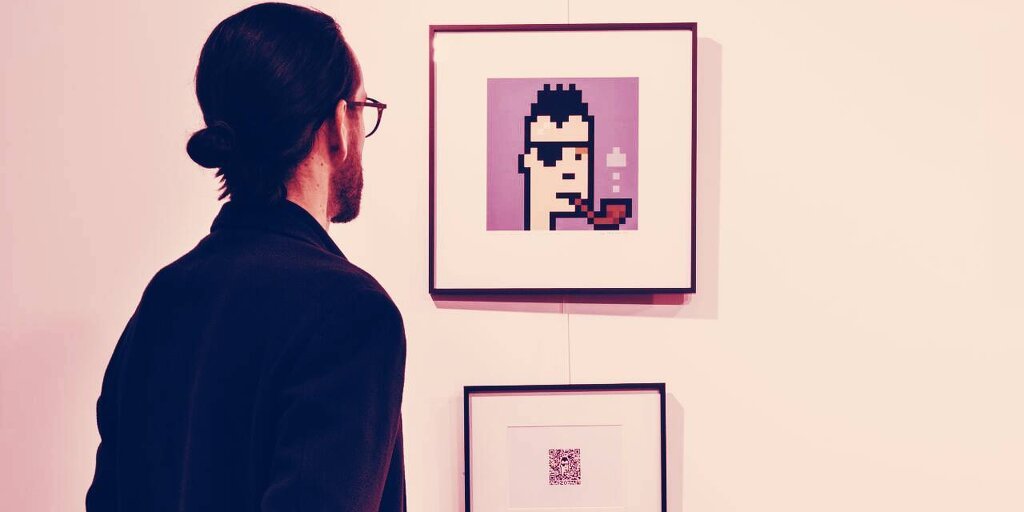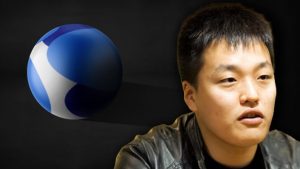Non-fungible tokens (NFTs) have taken the art world by storm in the past year, with headline-grabbing multi-million dollar sales propelling NFT creators like Beeple into the ranks of the world’s highest-paid artists. Venerable auction houses like Christie’s and Sotheby’s have seized on the opportunity, hosting sales of NFT collections like CryptoPunks and Bored Apes.
All of that raises a conundrum: how do you display this digital-only art once you’ve bought it? How do you present something as intangible as a digital file in a real-world setting? And what’s the best way to showcase an NFT of an animated GIF?
Art galleries are wrestling with this question, as their existing customers from the traditional art world begin to dip their toes in the NFT waters.
Decrypt recently visited two London galleries that have taken very different approaches to how to present NFTs.
First up, Decrypt headed to London’s ritzy Mayfair district, where the House of Fine Art’s Portrait of an Era exhibition showcased mostly physical artworks linked to NFTs; prints, sculptures and crypto-adjacent works.

Hanging on the walls were Sealed CryptoPunks—framed lithographs of the pixel art avatars, hung next to a sealed envelope containing the seed phrase to the wallet holding the punk. 3D-printed Meebits jostled for space with prints of Fidenza generative artworks and Bored Apes. And artwork by the gallery’s roster of traditional, established artists is paired with NFTs, and presented alongside works by NFT creators.
“We’re really trying to blur the lines,” said HOFA’s head of digital, Jake Elias. “For us to suddenly go, ‘Guys, can you move over for this whole new space?’—we didn’t think it was right.”
Instead, HOFA aimed to integrate traditional artists with the emerging space of NFTs, and “make them feel like they are a part of it,” Elias said. “By doing this and putting them alongside Glyphs, Fidenzas, Punks—they’re now like, wow, this space is giving them even more purpose.”

One example is the artist Johnny Dowell, aka King Nerd. His medium of choice—engraved coins—was a natural fit for the crypto space, said Elias. “He’s always worked with old coins; his whole process now is, ‘I can’t even buy a coffee with a coin, so I’ll go completely the other way.'” King Nerd’s piece for the exhibition, “Tulip mania,” is a physical coin engraved with tulips and ETH icons. In the accompanying animated NFT, “they kind of grow,” Elias explained.
‘Sensory overload’
A few miles away, in Covent Garden, the Unit London gallery took a very different approach with its exhibition, NFTism: No Fear in Trying. There’s no concession made to the legacy art world here; the first thing to hit you upon entering is a riot of color and light from a wall of video screens, all displaying animated NFT artworks.

“They’re a kind of sensory overload, but it’s meant to be a sensory overload,” Abigail Miller, Program Coordinator at NFT platform Institut, told Decrypt. “It really plays from the French salons where you have a hundred paintings across one wall; the whole point of a salon wall is that you take it all in.” With digital art, she explained, “you don’t have to have a hundred screens, but you can have some in rotation—I think there’s over 20 artists on that wall being played.”
The team made a conscious decision to lean towards animated digital displays, Miller said. “We decided you’ve seen a lot of NFT shows print them out—and that’s great if maybe it’s a still,” she told Decrypt. “We wanted to give an experience like this is the file, maybe it’s a slightly different resolution, but this is what you’re getting.”

The curators have noticed a trend towards videos and animated NFTs—”Videos tend to be more flashy,” said Miller—and the exhibition is accompanied by a parallel show in the metaverse.
That’s not to say there was no place in the show for physical artworks and static images, though. Indeed, some of the cleverest works on show juxtaposed the physical and the digital to neat effect. Mauro C Martinez’s “The Virgin Oil Painting vs. The Chad NFT” is a diptych that only makes sense when you see the digital work next to the physical painting.
“That piece is brilliant,” enthused Institut co-founder Joe Kennedy. “It just hits the nail on the head, the cognitive dissonance that’s going on around NFTs—particularly from the legacy art world.”
The Virgin Oil Painting vs. The Chad NFT.
Physical painting + NFT diptych.
Thank you @fercferrer for modeling The Chad so perfectly — couldn’t have done this project without you!
Recently on view @institutco ‘s NFTism (No Fear in Trying) curated by @kennyschac
— Mauro C Martinez (@ztm_oruam) October 1, 2021
One of the highlights for Kennedy was juxtaposing artists from the legacy art world and the new wave of NFTs. “For us, it was really interesting to have an artist like Jake Chapman, for example—one of the YBAs [Young British Artists]—creating his first NFT and having that juxtaposed with a Krista Kim, or a Brendan Dawes; these artists who really come from totally different worlds,” said Kennedy.
For both Institut and the House of Fine Art, a large part of the shows has involved educating artists from the traditional art world on the finer points of NFTs.

“We’ve taken the emerging talent from the contemporary world of art, the traditional world of art, and help them find their way in NFTs and the metaverse, basically,” explained the House of Fine Art’s Elias. A previous exhibition, Matter and Form, saw artists creating physical works alongside parallel digital works. “It was just an easier way for them to get their heads around the whole perception of digital art,” said Elias.
Institut and Unit London went as far as creating a “dummies’ guide to NFTs” video for the artists, “essentially just explaining blockchain, the utility of an NFT, in a way that’s hopefully digestible for people to understand in a minute,” said Kennedy.
It also ended up throwing up some philosophical conundrums. “Whether an NFT can even be called art or not is a question that we could debate for centuries,” Kennedy said. “The visual presentation of the work is not really the NFT; the NFT is the contract you get when you own the work, as opposed to the visual representation of the art itself.”
There’s also the question of whether the NFT is part of the artwork. “Are they mutually exclusive? Are they one and the same thing? That’s a question,” Kennedy reflected, “that everyone’s still trying to grapple with.”






















